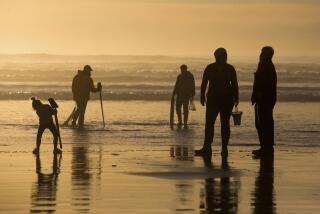For Maine Lobstermen, Harvests Not Created Equal
- Share via
PEMAQUID, Maine — After years of watching abundant catches by lobstermen that dwarf his own just a dozen miles away in Knox County, Brian McLain would just as soon not hear about it.
“I don’t even like to call them and talk to them anymore,” said McLain, steering his lobster boat toward New Harbor to drop off his catch after a hard day’s work. “A friend of mine fishes there, and he caught double what I caught. It’s annoying.”
The boom in lobster landings has not been shared equally by Maine lobstermen, as McLain’s lament suggests.
And the key boom area--Penobscot Bay--is under scrutiny these days as scientists study why the catch along one section of coast is outpacing the rest of the state so dramatically.
Landings have soared to record heights over the last 10 years, the counties around Penobscot Bay leading the way, according to a computer analysis of National Marine Fisheries Service data by the Associated Press.
But scientists fear the boom won’t last.
“At some point, as a state, we have to be prepared for a downturn,” said Carl Wilson, chief lobster biologist for the Maine Department of Marine Resources.
Penobscot Bay has long been one of the most productive lobstering grounds in the world. For one thing, the bay’s rocky bottom provides lots of nooks and crannies where developing lobster larvae can hide from ocean predators, Wilson said.
“Basically, they’ve got this big tail that everyone likes to eat, but fish like to eat them as well,” he said. “They’re always seeking shelter.”
In Knox County, which covers the bay’s western half, the 19.1 million pounds landed in 1999 is three times the amount landed in 1989. The county total had never exceeded 6.5 million pounds since 1964, the earliest year for which data were available.
Hancock County, covering the bay’s eastern half, came in second in 1999 with 10.8 million pounds, up from 4.3 million a decade earlier.
An increase in lobster fishermen does not appear to account for the increase. The counties’ combined landings for 1999 were more than double the 1990 figure, while the number of licenses increased by only about half.
The Knox County totals include a small number of landings from Waldo County, the third county ringing the bay, which had only 196 lobster licenses in 1999, said Bob Morrill of the National Marine Fisheries Service.
One other county, Cumberland, reported big gains during the same period. The other coastal counties, Lincoln, Sagadahoc, Washington and York, were either flat or showed more modest gains.
Concern for the state of the fishery remains, despite soaring numbers capped by a record catch of 52.3 million pounds worth $180 million in 1999. Escape vents in traps, an increase in the legal size limits and other conservation measures have been put in place to protect young lobsters and older, larger lobsters that can produce thousands of eggs apiece.
A report done for the Atlantic States Marine Fisheries Commission in June found that strong egg production was keeping lobster stocks from being depleted, but scientists still predict a downturn.
Many lobstermen disagree and say the bountiful landings show that the warnings are off base.
The Island Institute in Rockland is coordinating an effort by federal, state and private scientists to come up with better answers.
The project has used satellite images to study the water currents that are thought to bring juvenile lobsters to Penobscot Bay. Fishermen and scientists have cooperated on tagging young lobsters and keeping track of where they turn up next. And divers have studied baby lobster on the ocean bottom.
The goal of the project, which is entering its fifth year, is to create a model that can predict when lobster landings might start to drop.
“Everybody needs to know whether this boom can last,” said Philip Conkling, president of the Island Institute.
Experts say that some fishermen have invested so much to take advantage of the boom that any downturn could be financially devastating. Pat White, executive director of the Maine Lobstermen’s Assn., said many in the industry appear to have overextended themselves over the last 10 to 15 years.
“A lot of people have gone out and bought big boats and jumped into the business, instead of growing into it as they’ve done in generations past,” White said.
McLain said he has seen plenty of new faces in recent years in the section of Johns Bay where he has been lobstering since 1974, when he started out in the business with just 10 lobster traps.
Despite more lucrative landings a few miles up the coast, he has no desire to stand in line for a lobster license to fish in Knox County.
Business remains solid all the same, but McLain worries about the effects of unpredictable problems--such as lobster die-offs, which struck Long Island Sound. “There’s so many things that could devastate you,” he says.
More to Read
Sign up for Essential California
The most important California stories and recommendations in your inbox every morning.
You may occasionally receive promotional content from the Los Angeles Times.













